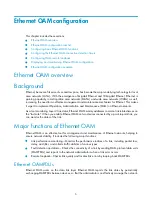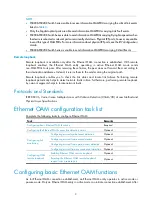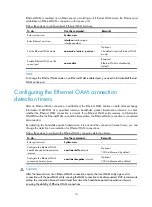
2
MTTR = fault detection time + hardware replacement time + system initialization time + link recovery time
+ routing time + forwarding recovery time. A smaller value of each item means a smaller MTTR and a
higher availability.
High availability technologies
As previously mentioned, increasing MTBF or decreasing MTTR can enhance the availability of a
network. The high availability technologies described in this section meet the level 3 high availability
requirements in the aspect of decreasing MTTR.
High availability technologies can be classified as fault detection technologies or protection switchover
technologies.
Fault detection technologies
Fault detection technologies enable detection and diagnosis of network faults. CFD, DLDP, Ethernet OAM,
and MPLS OAM are data link layer fault detection technologies; BFD is a generic fault detection
technology that can be used at any layer; NQA is used for diagnosis and evaluation of network quality;
Monitor Link and Track work along with other high availability technologies to detect faults through a
collaboration mechanism. For more information about these technologies, see
Table 2
Fault detection technologies
Technology Introduction
Reference
CFD
Connectivity Fault Detection (CFD), which conforms to IEEE
802.1ag Connectivity Fault Management (CFM) and ITU-T
Y.1731, is an end-to-end per-VLAN link layer Operations,
Administration and Maintenance (OAM) mechanism used for link
connectivity detection, fault verification, and fault location.
CFD configuration in
the
High Availability
Configuration Guide
DLDP
The Device link detection protocol (DLDP) deals with
unidirectional links that may occur in a network. On detecting a
unidirectional link, DLDP, as configured, can shut down the
related port automatically or prompt users to take actions to avoid
network problems.
DLDP configuration in
the
High Availability
Configuration Guide
Ethernet OAM
As a tool monitoring Layer 2 link status, Ethernet OAM is mainly
used to address common link-related issues on the “last mile”. You
can monitor the status of the point-to-point link between two
directly connected devices by enabling Ethernet OAM on them.
Ethernet OAM
configuration in the
High Availability
Configuration Guide
BFD
Bidirectional forwarding detection (BFD) provides a single
mechanism to quickly detect and monitor the connectivity of links
or IP forwarding in networks. To improve network performance,
devices must quickly detect communication failures to restore
communication through backup paths as soon as possible.
BFD configuration in
the
High Availability
Configuration Guide
NQA
Network Quality Analyzer (NQA) analyzes network
performance, services and service quality through sending test
packets, and provides you with network performance and service
quality parameters such as jitter, TCP connection delay, FTP
connection delay and file transfer rate.
NQA configuration in
the
Network
Management and
Monitoring
Configuration Guide















































